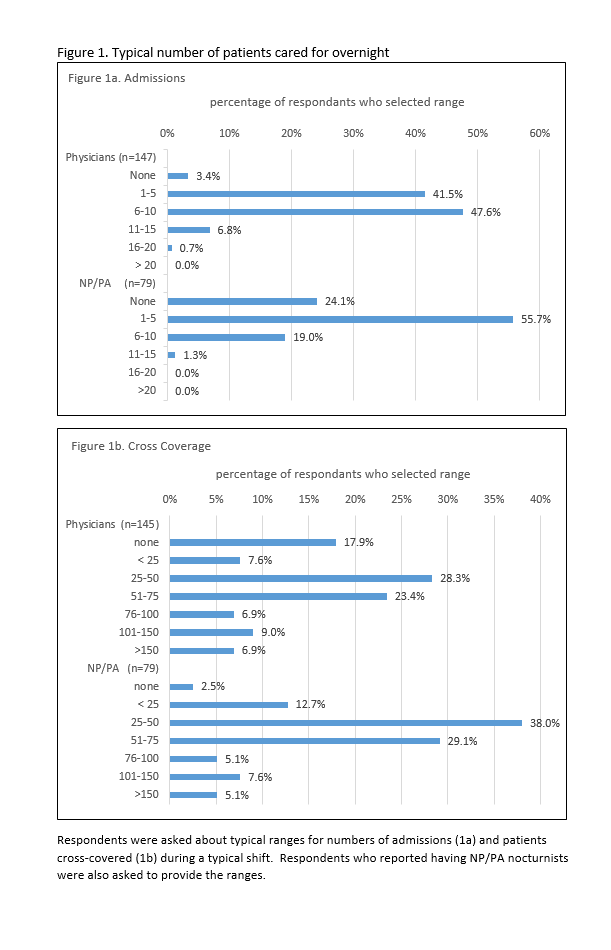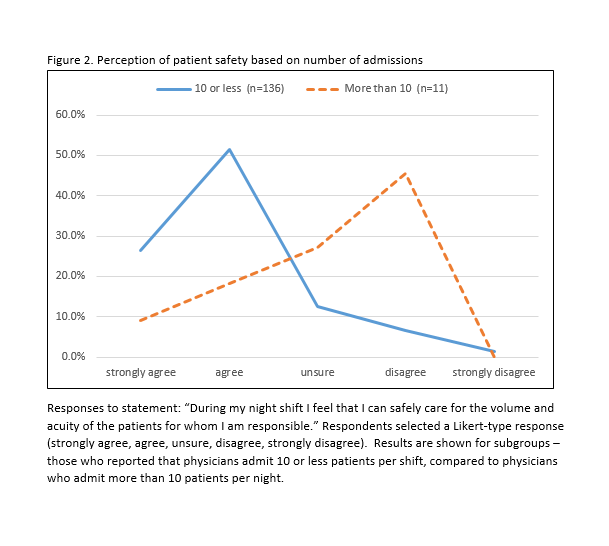Background: Although in-person hospitalist presence, increasingly staffed by dedicated nocturnists, has become the norm overnight in the hospital (1-2), the scope of nocturnist practice and the typical workload has not been defined.
Methods: In November 2019 a survey was created by a panel of nocturnists made up of members of the SHM Night Medicine Special Interest Group. The survey was posted on the SHM Hospital Medicine Exchange (HMX) Online Discussion Forum, on both the open and Night Medicine pages. Additionally, since many nocturnists are not active on this site and do not exist in a single database, the survey was distributed in a “snowball” method by the panel members to night clinicians they personally knew. All participants were then asked to forward the survey to other clinicians who performed night work.
Results: 167 people responded to the survey with 148 reporting that they work night shifts (71% physicians, 21% NP/PA). There was at least 1 respondent from 32 different states. At night, the primary responsibility of hospitalists included admitting patients to medical services (99%), cross-covering inpatients (95%), admitting patients to non-medical services (29%), admitting and covering ICU patients (28%), triaging to medical services (28%), admitting and covering rehab patients (7%). Secondary responsibilities include performing consults (83%), RRT/Code team (68%), medical education (28%), triage to medical services (21%), procedure team (9%), outpatient calls for primary care or nursing home (9%), and telemedicine (3%). While they are admitting patients, 91% also have other secondary tasks to perform. Physician hospitalists most frequently perform 6-10 (48%) admissions per night, and most NP/PA hospitalists perform 1-5 (56%) or zero admissions (Figure 1a). Most hospitalists take between 30 minutes and 2 hours to complete an admission. When doing cross-coverage (Figure 1b), most physicians cover 25-50 (28%), followed by 51-75 patients (23%). Similarly, most NP/PA’s cover 25-50 (38%) followed by 51-75 (29%). Some MD and NP/PA’s report covering over 100 patients. When asked how many admissions the hospitalist feels a physician can admit overnight while still providing safe, high-quality care, they most frequently selected a range of 5-10 patients. For NP/PA’s the range was most frequently 6 or less. Most hospitalists feel both physicians and NP/PAs can safely cross cover 25-75 patients overnight. Most hospitalists agree or strongly agree they can safely care for the volume and acuity of patients for whom they are responsible, though 14% are unsure and 10% disagree. When comparing those who reported that physicians perform up to 10 admissions per night (n=136) with those who perform more than 10 admissions (n=11), those who performed less admissions were more likely to agree that they could provide safe care (78% vs 27%, p=0.0002) (Figure 2).
Conclusions: Hospitalists who perform overnight work have many responsibilities. Workload is variable between institutions, though it often falls into a typical range. While differences in job descriptions are expected given the diversity of practice settings, some clinicians feel they are unable to provide safe care. Our data reveal that a high number of admissions per night negatively impacts clinician perception of safety. When night hospitalists report concerns about safe workloads, hospital leaders should ensure the expectations overnight are reasonable. Further guidelines as to ideal patient volume per night clinician are needed.


